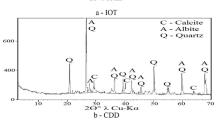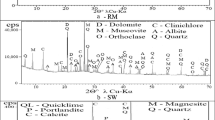Abstract
The article presents data from new compositions of construction materials developed from three types of Kazakhstan enterprises’ industrial waste—highly alkaline (pH = 13.5) hazardous sludge of phosphogypsum (PG) waste from Karatau deposits (52–78 wt.%), ground-cooled converter slag (CS) from Karaganda Metallurgical Plant (20–45%), and lime production waste (LPW) from a small plant near Astana (2%). This research aimed to develop new compositions of materials, which correspond to Kazakhstan’s mechanical and environmental standards, to study the processes of new composites’ structure formation in the process of their hydration and resistance strengthening. The axial compressive-resistance values of the developed composites reached 5.3–6.8–9.6 and 14.9 MPa after 3, 7, 14, and 550 days of hydration, respectively; the values of the coefficient of linear expansion were in the range of 0.23 and 3.14%, and those of water absorption between 8.2 and 18.4%. The formation processes of the materials’ structure were studied by the XRD, SEM, EDS, AAS, and LAMMA methods. The analyses of the solubility and leaching of metals by the AAS method showed the compliance of the new compositions with Kazakhstan’s sanitary standards.





Similar content being viewed by others
References
Hawking SW (2018) http://www.independent.co.uk/news/science/stephen-hawking-pollution-stupidity-artifical-intelligence-warfare-biggest-threats-mankind-a7106916.html
Yang JL et al (2009) Preparation of load-bearing building materials from autoclaved phosphogypsum. J Constr Build Mat 23:687–693
Gennari RF et al (2011) Phosphogypsum analysis: total content and extractable element concentrations. Int Nuclear Atlantic Conference - INAC 2011, Belo Horizonte, MG, Brazil
Federal Register (1990) National emission standards for radon emission from phosphogypsum stacks, 55: 40834
Kelly AR et al (2002) Stabilization of phosphogypsum using class C fly ash and lime: assessment of the potential for marine applications. J Hazard Mater 93:167–186
Sen T, Mishra U (2010) Usage of industrial waste products in village road construction. Int J Environ Sci Dev 1:122–126
Chen X et al (2018) Effect of neutralization on the setting and hardening characters of hemihydrate phosphogypsum plaster. J Constr Build Mater 190:53–64. https://doi.org/10.1016/j.conbuildmat.2018.09.095
Chen Q et al (2017) Utilization of phosphogypsum and phosphate tailings for cemented. J Environ Manag 201:19–27. https://doi.org/10.1016/j.jenvman.2017.06.027
Gijbels K et al (2019) Feasibility of incorporating phosphogypsum in ettringite-based binder from ladle slag. J Clean Prod 237:117793. https://doi.org/10.1016/j.jclepro.2019.117793
Taher MA (2007) Influence of thermally treated phosphogypsum on the properties of Portland slag cement. Resour Conserv Recycl 52:28–38
Contreras M et al (2018) Influence of the addition of phosphogypsum on some properties of ceramic tiles. J Constr Build Mater 175:588–600. https://doi.org/10.1016/j.conbuildmat.2018.04.131n
Nizevičienė D et al (2016) Effects of waste fluid catalytic cracking on the properties of semi-hydrate phosphogypsum. J Clean Prod 137:150–156. https://doi.org/10.1016/j.jclepro.2016.07.037
Yang L et al (2016) Utilization of original phosphogypsum as raw material for the preparation of self-leveling mortar. J Clean Prod 127:204–213. https://doi.org/10.1016/j.jclepro.2016.04.054
Wang Q et al (2020) Study on the improvement of the waterproof and mechanical properties of hemihydrate phosphogypsum-based foam insulation materials. J Constr Build Mater 230:117014. https://doi.org/10.1016/j.conbuildmat.2019.117014
Rychkov VN et al (2018) Recovery of rare earth elements from phosphogypsum. J Clean Prod 196:674–681. https://doi.org/10.1016/j.jclepro.2018.06.114
Rosales J et al (2020) Treated phosphogypsum as an alternative set regulator and mineral addition in cement production. J Clean Prod 20:118752. https://doi.org/10.1016/j.jclepro.2019.118752
Vaičiukynienė D et al (2018) Effect of phosphogypsum on the stability upon firing treatment of alkali-activated slag. J Constr Build Mater 184:85–491. https://doi.org/10.1016/j.conbuildmat.2018.06.213
Szajerski P et al (2019) Quantitative evaluation and leaching behavior of cobalt immobilized in sulfur polymer concrete composites based on lignite fly ash, slag and phosphogypsum. J Clean Prod 222:90–102. https://doi.org/10.1016/j.jclepro.2019.03.010
Ma B et al (2020) Utilization of hemihydrate phosphogypsum for the preparation of porous sound absorbing material. J Constr Build Mater 234:117346. https://doi.org/10.1016/j.conbuildmat.2019.117346
Mattiello EM et al (2016) Soluble phosphate fertilizer production using acid effluent from metallurgical industry. J Environ Manag 166:140–146. https://doi.org/10.1016/j.jenvman.2015.10.012
Sahu S et al (2014) Natural radioactivity assessment of a phosphate fertilizer plant area. J Radiat Res Appl Sci 7:123–128. https://doi.org/10.1016/j.jrras.2014.01.001
Al-Hwaiti M, Al-Khashman O (2015) Health risk assessment of heavy metals contamination in tomato and green pepper plants grown in soils amended with phosphogypsum waste materials. J Environ Geochem Health 37:287–304. https://doi.org/10.1007/s10653-014-9646-z
Mohammed F et al (2018) Sustainability assessment of symbiotic processes for the reuse of phosphogypsum. J Clean Prod 188:497–507. https://doi.org/10.1016/j.jclepro.2018.03.309
World Steel Association (2019) https://www.worldsteel.org/en/dam/jcr:1b916a6d-06fd-4e84-b35d-c1d911d18df4/Fact_By-products_2018.pdf
Guo J et al (2018) Steel slag in China: treatment, recycling, and management. J Waste Manag 78:318–330. https://doi.org/10.1016/j.wasman.2018.04.045
Zouboulis A (2004) Biosorption of toxic metals from aqueous solutions by bacteria strains isolated from metal-polluted soils. J Process Biochem 39:909–916
Kumar S et al (2008) Mechanical activation of granulated blast furnace slag and its effect on the properties and structure of portland slag cement. J Cem Concr Compos 30:679–685
Cao L et al (2019) Process to utilize crushed steel slag in cement industry directly: multi-phased clinker sintering technology. J Clean Prod 217:520–529. https://doi.org/10.1016/j.jclepro.2019.01.260
Mymrin VA (1987) The theoretical basis for the resistance strengthening of clay soils dump slags ferrous metallurgy to create the foundations of roads. Diss Dr Geol Miner Sci, Moscow State University (MGU) Lomonosov Moscow
Liu ZB et al (2014) Effect of (CaO+MgO)/SiO2 ratio on crystallisation and properties of slag glass–ceramics. J Adv Appl Ceram 113:411–418
Li X et al (2019) Separation and purification of silicon from cutting kerf-loss slurry waste by electromagnetic and slag treatment technology. J Clean Prod 211:695–703. https://doi.org/10.1016/j.jclepro.2018.11.195
Wang L et al (2017) Recovery of rare earths and aluminum from FCC catalysts manufacturing slag by stepwise leaching and selective precipitation. J Environ Chem Eng 5:3711–3718. https://doi.org/10.1016/j.jece.2017.07.018
Mombelli D et al (2018) Characterization of cast iron and slag produced by jarosite sludges reduction via Arc Transferred Plasma (ATP) reactor. J Environ Chem Eng 6:773–783. https://doi.org/10.1016/j.jece.2018.01.006
Jamshidi A et al (2015) Analysis of structural performance and sustainability of airport concrete pavements incorporating blast furnace slag. J Clean Prod 90:195–210
Etxeberria M et al (2010) Properties of concrete using metallurgical industrial by-products as aggregates. J Constr Build Mater 24:1594–1600
Lübeck A et al (2012) Compressive resistance and electrical properties of concrete with white Portland cement and blast-furnace slag. J Cem Concr Compos 34:392–399
Özbay E et al (2016) Utilization and efficiency of ground granulated blast furnace slag on concrete properties. A Rev J Constr Build Mater 105:423–434
Monosi S et al (2016) Electric arc furnace slag as natural aggregate replacement in concrete production. J Cem Concr Comp 66:66–72
Yeih W et al (2015) Properties of pervious concrete made with air-cooling electric arc furnace slag as aggregates. J Con Buil Mat 93:737–774
Bhatty J, Gajda I (2004) Alternative materials. J. World Cem 35:41–48
Mymrin V (2012) Industrial and municipal wastes utilization as economical and environment efficient raw materials, http://paginapessoal.utfpr.edu.br/mymrinev
CN-25–74(2011) Instructions for the use of soils, reinforced with binders, for the construction of foundations and roads and airfields. Moscow
Ramachandran VS et al (2002) Handbook of Thermal Analysis of Construction Materials. DOI: https://doi.org/10.1016/S0040-6031(03)00230-2
GOST 9179-77 (2018). Building Lime Technical Conditions. Lime for building purposes. Specifications
GOST 530-2012 (2018) Ceramis brick and stone. General specifications. Astana, Kazakhstan
PDK SanPiN 2.1.7.1287-03 (2003) Sanitary and epidemiological requirements for soil quality. Astana, Kazakhstan
Acknowledgements
The authors express their gratitude to the Committee of Science and the Ministry of Education and Science of the Republic of Kazakhstan for the financial support of the research work carried out under this project N° 149 of 14.03.2018.
Author information
Authors and Affiliations
Contributions
VM—conceptualization, supervision of all the studies, and original draft writing. EKA—resources and raw materials. MAA—laboratory works and editing of English language. KA—formal laboratory analysis. MAA—laboratory works. KQC—laboratory works and review of original text. AE—samples’ preparation. REC—methodology.
Corresponding author
Ethics declarations
Conflict of interest
We have no conflict situation with any of the researchers or with a group of researchers.
Additional information
Publisher's Note
Springer Nature remains neutral with regard to jurisdictional claims in published maps and institutional affiliations.
Rights and permissions
About this article
Cite this article
Mymrin, V., Aibuldinov, E.K., Avanci, M.A. et al. Material cycle realization by hazardous phosphogypsum waste, ferrous slag, and lime production waste application to produce sustainable construction materials. J Mater Cycles Waste Manag 23, 591–603 (2021). https://doi.org/10.1007/s10163-020-01147-7
Received:
Accepted:
Published:
Issue Date:
DOI: https://doi.org/10.1007/s10163-020-01147-7




